ON THE SIXTEENTH NIGHT OF HALLOWEEN … I watched Mother of Tears (2007) by Dario Argento. This is the third entry in Argento’s Three Mothers trilogy, after Suspiria (1977), which is Argento’s masterpiece, and Inferno (1980). The Three Mothers are: the Mother of Sighs, or Mater Suspiriorum, who is the villain of Suspiria; the Mother of Darkness, or Mater Tenebrarum, who is the villain of Inferno; and the Mother of Tears, or Mater Lachrymarum, the villain here. Argento derived his three witch matriarchs from a brief passage in Thomas De Quincey’s "Suspiria de Profundis," in which the Mothers are imagined as consorts to the Roman goddess Levana. Even after three movies’ worth of protagonists fervently investigating and expositing on the Mothers and their millennia-spanning conspiracy, Argento’s witch mythology remains utterly impenetrable to me—which is what I love about it. We are told that the Mothers are thousands of years old and have the power to bring about an apocalypse through strange artefacts, and we finally see that apocalypse take place in this movie, through gleefully unhinged scenes of pedestrians driven by sorcerous hysteria to become sex-crazed homicidal maniacs who fling their own infants off bridges and smear their victims’ entrails on their naked bodies. We also learn that the Mothers already rule the world from three buildings that act as their centers of power. At times it seems that the Mothers can be killed by simply stabbing them while at other times it seems that they are deathless archetypes. Meanwhile, their globe-spanning coven seems to be both a sophisticated illuminati-like organization and a gang of drunken punks who spring up from the gutters at the behest of some irrepressible primeval call. That is, everything we learn about Argento’s witch mythos raises further questions and pushes us further into darkness, giving us only enough of a glimpse at each step to leave us more intimidated. Which is excellent. Many a lesser supernatural horror series has been spoiled by spelling out the black magic according to mundane mechanics.
But I suppose I should say something about this movie in particular. It’s by far the worst of the three, but that’s not to say it doesn’t offer a fun watch, owing pretty much entirely to Argento’s undiminished talent for making sharp turns into insanity. The problem is not that Argento has lost any of his chaotic magic in the decades since Inferno. It’s that unlike the first two entries, which are tightly focused on exploring a single building, this narrative takes us all over the place and never coheres around a strong dramatic through line. And this is clearly a problem that Argento was aware of and struggled with, since he had originally planned to conclude the trilogy in 1984 but was so unsatisfied with the script at the time that he scrapped the project. Many more rewrites and twenty years later, I suppose he decided to just shoot the best that he could come up with before it was too late. I think he must have wanted to expand the scope of the action to an apocalyptic scale for the series conclusion, but he was never able to find a way to do that while maintaining the claustrophobic occult atmosphere that defines the first two Mothers movies.


No comments:
Post a Comment